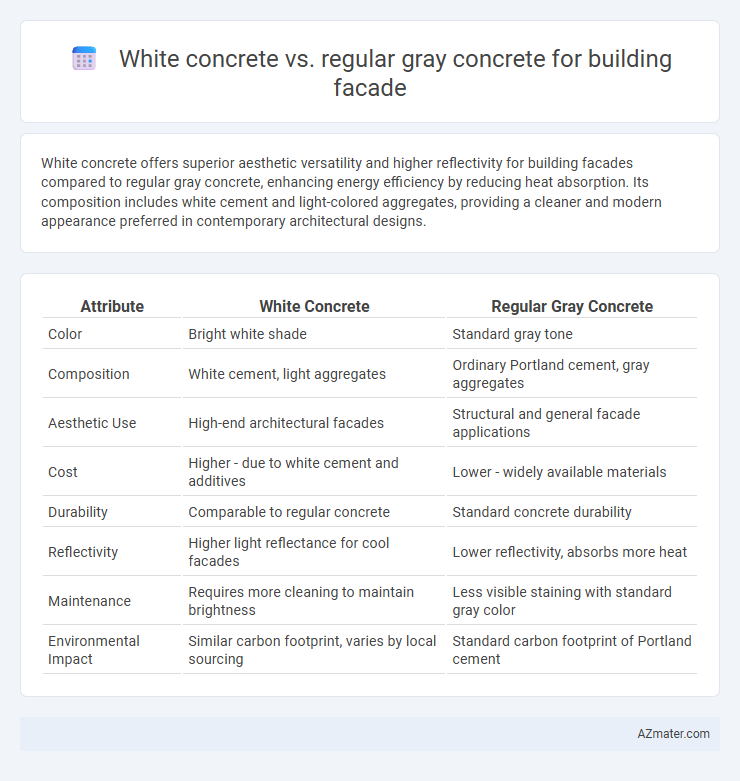White concrete offers superior aesthetic versatility and higher reflectivity for building facades compared to regular gray concrete, enhancing energy efficiency by reducing heat absorption. Its composition includes white cement and light-colored aggregates, providing a cleaner and modern appearance preferred in contemporary architectural designs.
Table of Comparison
| Attribute | White Concrete | Regular Gray Concrete |
|---|---|---|
| Color | Bright white shade | Standard gray tone |
| Composition | White cement, light aggregates | Ordinary Portland cement, gray aggregates |
| Aesthetic Use | High-end architectural facades | Structural and general facade applications |
| Cost | Higher - due to white cement and additives | Lower - widely available materials |
| Durability | Comparable to regular concrete | Standard concrete durability |
| Reflectivity | Higher light reflectance for cool facades | Lower reflectivity, absorbs more heat |
| Maintenance | Requires more cleaning to maintain brightness | Less visible staining with standard gray color |
| Environmental Impact | Similar carbon footprint, varies by local sourcing | Standard carbon footprint of Portland cement |
Introduction to Concrete Types for Building Façades
White concrete, characterized by its high purity white cement and light-colored aggregates, offers an aesthetically appealing, bright finish ideal for modern building facades. Regular gray concrete is composed of ordinary Portland cement with common aggregates, providing a durable, cost-effective solution but with a more industrial appearance. Selection between white and gray concrete for facades depends on factors like desired visual impact, environmental conditions, and budget constraints.
Composition Differences: White Concrete vs Gray Concrete
White concrete differs from regular gray concrete primarily in its use of white Portland cement and light-colored aggregates such as quartz or limestone, which reduce iron content and prevent the typical gray hue. In contrast, gray concrete incorporates ordinary Portland cement rich in iron oxides, contributing to its darker pigmentation and slightly different chemical properties. These compositional differences influence not only aesthetic outcomes but also curing behavior and durability characteristics essential for building facade applications.
Aesthetic Appeal and Color Consistency
White concrete offers superior aesthetic appeal for building facades due to its clean, bright appearance and ability to showcase vibrant architectural designs with consistent color tones. Unlike regular gray concrete, which may exhibit color variations and dullness over time, white concrete maintains uniformity and enhances visual impact in natural and artificial lighting. The inherent brightness of white concrete provides architects with greater creative freedom to achieve precise color matching and design intent.
Surface Finish Options and Architectural Versatility
White concrete offers a smoother and brighter surface finish that enhances the aesthetic appeal of building facades, enabling a wider range of color options and decorative effects compared to regular gray concrete. Its high reflectivity improves natural light diffusion, making it ideal for modern architectural designs requiring clean, vibrant finishes. Regular gray concrete provides a more traditional, rugged texture suitable for industrial or minimalist facades, but lacks the versatility and visual impact achievable with white concrete in contemporary architectural applications.
Durability and Weather Resistance
White concrete exhibits enhanced durability and superior weather resistance compared to regular gray concrete, largely due to its lower heat absorption and reduced thermal expansion, which minimizes cracking and surface degradation. The high reflectivity of white concrete protects facades from UV damage and reduces thermal stress, extending the lifespan of the building exterior in harsh climates. Regular gray concrete, while robust, tends to retain more heat and be more susceptible to weathering effects such as freeze-thaw cycles and efflorescence, potentially requiring more frequent maintenance.
Cost Comparison and Project Budget Impact
White concrete typically costs 15-30% more than regular gray concrete due to the use of specialized white cement and additional pigmentation materials. This higher upfront expense can significantly impact the project budget, especially for large-scale building facades where material volume is substantial. However, the premium on white concrete may be offset by potential savings in coatings or finishes, as its aesthetic appeal often reduces the need for external treatments.
Sustainability and Environmental Considerations
White concrete for building facades offers enhanced sustainability benefits due to its higher albedo, reflecting more sunlight and reducing urban heat island effects compared to regular gray concrete. The reduced cooling load in buildings with white concrete facades lowers energy consumption and associated carbon emissions, making it an eco-friendly choice. However, sourcing materials for white concrete can sometimes involve higher embodied energy, necessitating a balanced approach in life-cycle assessments for environmental impact.
Maintenance Requirements Over Time
White concrete facades require specialized cleaning methods to prevent discoloration and maintain their bright appearance, with periodic washing essential to remove dirt and pollutants that show more prominently than on gray surfaces. Regular gray concrete tends to conceal stains and weathering better, reducing the frequency and intensity of maintenance interventions over time. Both materials benefit from sealants and protective coatings, but white concrete demands more vigilant care to preserve its aesthetic quality in building facades.
Applications in Modern Architectural Designs
White concrete offers superior aesthetic versatility in modern architectural designs by providing a clean, bright facade that enhances natural light reflection and complements minimalist styles. Its high albedo makes it ideal for urban environments aiming to reduce heat absorption, contributing to energy-efficient buildings. Regular gray concrete remains popular for its cost-effectiveness and structural reliability but lacks the visual sophistication and customization possibilities that white concrete delivers for contemporary building exteriors.
Choosing the Right Concrete for Your Building Façade
White concrete offers superior aesthetic appeal and reflects more sunlight, reducing building heat absorption compared to regular gray concrete, making it ideal for modern facades seeking energy efficiency and a clean look. Regular gray concrete provides versatility and cost-effectiveness with high durability, suitable for structural facades where budget and strength are primary concerns. Selecting the right concrete depends on balancing thermal performance, visual impact, and budget priorities for your building facade project.

Infographic: White concrete vs Regular gray concrete for Building façade
 azmater.com
azmater.com